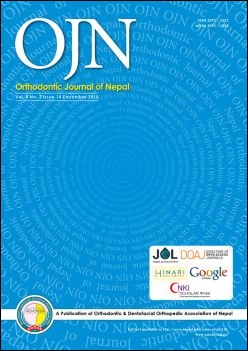A Clinical Evaluation of Effect of Positional Change of Mini Implant on Intrusion of Maxillary Incisors - A Randomized Clinical Trial
DOI:
https://doi.org/10.3126/ojn.v8i2.23063Keywords:
Deep bite, Intrusion, Mini implantAbstract
Introduction: A true maxillary intrusion is always a challenge for orthodontists. There are number of methods of incisor intrusion. Mini Implant assisted incisor intrusion is gaining popularity in recent years. We conducted this research to evaluate and compare the effect of different implant positioning on amount and rate of intrusion, axial and labiolingual inclination of incisors, amount of external apical root resorption of incisors.
Materials & Method: A prospective, double-blind, randomized clinical study was designed consisting of 30 adult or-thodontic patients, aged 25 and above. The subjects were divided into two groups (Group A-15 patients where mini-implant was placed between two maxillary central incisors below ANS, Group B -15 patients where mini- implant was placed distal to maxillary lateral incisor). Amount of intrusion and change in axial inclination was measured on OPG, labiolingual inclination was measured on Lateral cephalogram, IOPA was taken to observe EARR. The intragroup comparison of pre treatment and post treatment changes were done using Wil-coxon signed rank test, where as the intergroup comparison between Group A and Group B were compared using Mann Whitney U test.
Result: Statistically significant 3D changes of both central and lateral incisors were seen when continuous intrusion forces were applied from implant placed distal to lateral incisors. Whereas true intrusion with minimal (non significant) axial and labiolingual inclination changes were seen with forces applied through implant placed in the midline. 80 grams of light continuous forces brought about rapid tooth movement with no side effects such as tissue irritation and EARR.
Conclusion: Mini implant placed below ANS leads to true en-mass intrusion of four maxillary incisors while intrusion carried out with implant placed distal to lateral incisors bilaterally have 3D changes on all four maxillary incisors.
Downloads
Downloads
Published
How to Cite
Issue
Section
License
Copyright © held by Orthodontic & Dentofacial Orthopedic Association of Nepal
- Copyright on any research article is transferred in full to the Orthodontic & Dentofacial Orthopedic Association of Nepal upon publication in the journal. The copyright transfer includes the right to reproduce and distribute the article in any form of reproduction (printing, electronic media or any other form).
- Articles in the Orthodontic Journal of Nepal are Open Access articles published under the Creative Commons CC BY License (https://creativecommons.org/licenses/by/4.0/)
- This license permits use, distribution and reproduction in any medium, provided the original work is properly cited.




